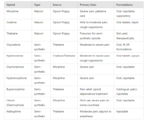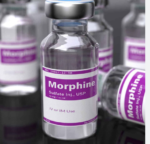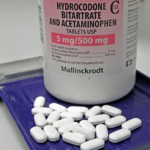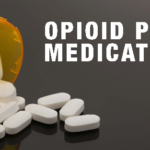Semi-synthetic opioids are chemically modified derivatives of natural opioids, typically morphine or thebaine. They are designed to improve efficacy, potency, or bioavailability, or to reduce side effects compared to natural opioids.
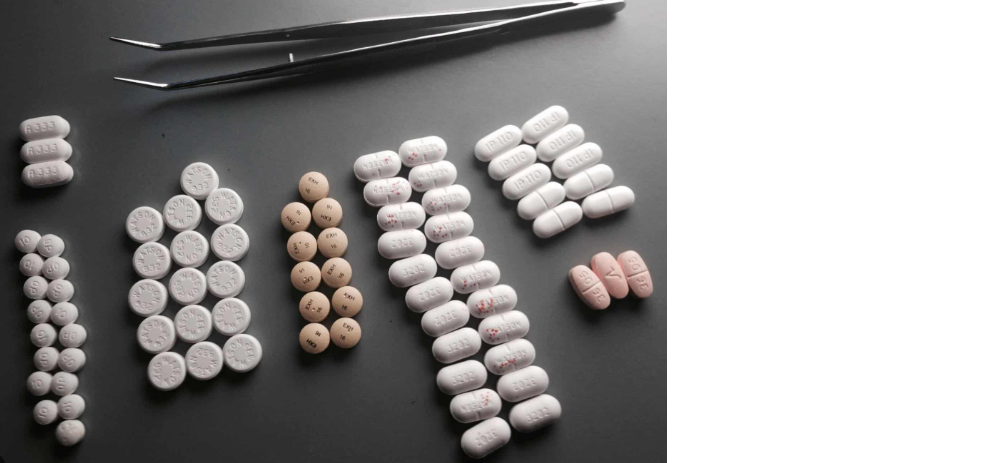
a. Oxycodone
- Source: Derived from thebaine.
- Medical Uses: Oxycodone is used for moderate to severe pain management, including cancer pain and post-operative pain. It is often available in combination with acetaminophen (e.g., Percocet) or in extended-release formulations (e.g., OxyContin).
- Formulations: Available in immediate-release (IR) and extended-release (ER) tablets, as well as oral solutions.
- Mechanism of Action: Oxycodone acts on mu-opioid receptors to relieve pain and produce feelings of euphoria.
- Side Effects: Common side effects include dizziness, nausea, constipation, and respiratory depression.
b. Hydrocodone
- Source: Derived from codeine or thebaine.
- Medical Uses: Hydrocodone is commonly used for moderate to severe pain as well as cough suppression in certain formulations. It is often combined with non-opioid pain relievers like acetaminophen (e.g., Vicodin).
- Formulations: Available in oral tablets, capsules, and syrups.
- Mechanism of Action: Hydrocodone binds to mu-opioid receptors in the central nervous system to reduce pain and suppress cough.
- Side Effects: Sedation, constipation, nausea, and potential for addiction and respiratory depression.
c. Oxymorphone
- Source: A semi-synthetic derivative of morphine.
- Medical Uses: Oxymorphone is used for managing severe pain, particularly in patients who are opioid-tolerant or dealing with chronic conditions such as cancer pain.
- Formulations: Available in immediate-release and extended-release formulations.
- Mechanism of Action: Similar to other opioids, oxymorphone works by activating mu-opioid receptors to produce pain relief and sedation.
- Side Effects: Drowsiness, dizziness, nausea, and the risk of respiratory depression, especially at high doses.
d. Hydromorphone
- Source: A semi-synthetic derivative of morphine.
- Medical Uses: Hydromorphone (brand name Dilaudid) is a potent opioid used for severe pain relief, particularly in cases where morphine may not be effective or is poorly tolerated.
- Formulations: Available in oral tablets, liquids, and injectable forms.
- Mechanism of Action: Hydromorphone is much more potent than morphine and acts on mu-opioid receptors to relieve pain.
- Side Effects: Commonly causes nausea, vomiting, constipation, and respiratory depression at high doses.
e. Buprenorphine
- Source: Derived from thebaine.
- Medical Uses: Buprenorphine is used for pain relief and opioid dependence treatment. It is a partial agonist at mu-opioid receptors, meaning it provides pain relief but with a ceiling effect that reduces the risk of overdose and addiction.
- Formulations: Available as sublingual tablets, patches, injections, and combined with naloxone in formulations like Suboxone for opioid addiction treatment.
- Mechanism of Action: Buprenorphine has a high affinity for mu-opioid receptors but activates them to a lesser degree than full agonists like morphine or oxycodone.
- Side Effects: Similar to other opioids, though less likely to cause respiratory depression due to its partial agonist activity.
f. Heroin (Diamorphine)
- Source: A semi-synthetic derivative of morphine, created by adding two acetyl groups to the morphine molecule.
- Medical Uses: In some countries, heroin is used medically for severe pain and palliative care, but it is mostly known for its illicit use as a recreational drug due to its potent euphoric effects.
- Formulations: When used medically, heroin is available in injectable or oral forms.
- Mechanism of Action: Heroin rapidly crosses the blood-brain barrier and is converted to morphine in the brain, binding to mu-opioid receptors to produce intense euphoria and pain relief.
- Side Effects: High risk of addiction, overdose, and respiratory depression. Heroin use is also associated with significant health risks such as infections, collapsed veins, and long-term damage to organs.
g. Nalbuphine
- Source: A semi-synthetic opioid derived from thebaine.
- Medical Uses: Used for moderate to severe pain and as an adjunct to anesthesia.
- Formulations: Injectable form.
- Mechanism of Action: Nalbuphine is a mixed agonist-antagonist opioid, meaning it acts as an agonist on kappa-opioid receptors (providing pain relief) and as an antagonist on mu-opioid receptors (reducing the risk of euphoria and abuse).
- Side Effects: Drowsiness, dizziness, and less potential for respiratory depression and abuse compared to full opioid agonists.
Abuse of Semi-Synthetic Opioids and Treatment/Prevention
Semi-synthetic opioids are derived from natural opiates but chemically modified to enhance potency, bioavailability, or other pharmacological properties. These opioids include oxycodone, hydrocodone, oxymorphone, hydromorphone, and others. While semi-synthetic opioids are effective for pain management, their high potency and addictive potential make them susceptible to abuse, leading to a range of harmful consequences, including opioid use disorder (OUD), overdose, and death.
This response will focus on the abuse of semi-synthetic opioids, the treatment approaches for opioid abuse, and strategies for preventing misuse.
1. Types of Semi-Synthetic Opioids Commonly Abused
a. Oxycodone
- Medical Uses: Oxycodone is prescribed for moderate to severe pain, often in extended-release forms (e.g., OxyContin) or in combination with non-opioid pain relievers like acetaminophen (e.g., Percocet).
- Abuse Potential: Oxycodone is highly addictive, and extended-release forms are particularly prone to abuse because individuals may crush the tablets for a more immediate and intense effect (e.g., snorting or injecting the crushed powder).
b. Hydrocodone
- Medical Uses: Hydrocodone is used for moderate to severe pain and as a cough suppressant. It is commonly combined with acetaminophen (e.g., Vicodin) for enhanced analgesia.
- Abuse Potential: Hydrocodone is widely abused, especially in oral formulations. Individuals may misuse it by taking higher-than-prescribed doses or combining it with other substances like alcohol or benzodiazepines to increase the euphoric effects.
c. Oxymorphone
- Medical Uses: Oxymorphone (Opana) is prescribed for severe pain, particularly in opioid-tolerant patients.
- Abuse Potential: Oxymorphone is very potent and is often abused by crushing the tablets and snorting or injecting them. This increases the risk of overdose and other complications.
d. Hydromorphone
- Medical Uses: Hydromorphone (Dilaudid) is a potent opioid used for severe pain, particularly in cases where other opioids may not be effective.
- Abuse Potential: Hydromorphone has a high potential for abuse due to its potency and rapid onset of effects, especially when injected.
e. Buprenorphine
- Medical Uses: Buprenorphine is used for pain relief and for treating opioid dependence. It has a unique partial agonist profile, reducing the risk of abuse compared to full opioid agonists.
- Abuse Potential: Though less prone to abuse than other semi-synthetic opioids, buprenorphine can still be misused, particularly when taken in higher doses or in combination with other depressants.
2. Consequences of Semi-Synthetic Opioid Abuse
a. Health Risks
- Overdose: Abuse of semi-synthetic opioids can result in life-threatening respiratory depression. The risk of overdose is especially high when opioids are combined with other central nervous system depressants like alcohol or benzodiazepines.
- Physical Dependence and Tolerance: Repeated use of semi-synthetic opioids can lead to tolerance (requiring higher doses to achieve the same effect) and physical dependence (withdrawal symptoms when stopping the drug).
- Infectious Diseases: Injecting opioids increases the risk of blood-borne diseases such as HIV and hepatitis, especially when needles are shared.
b. Psychological and Social Effects
- Addiction: Semi-synthetic opioids are highly addictive. Individuals may prioritize drug-seeking behaviors over personal responsibilities, leading to job loss, relationship problems, and financial instability.
- Mental Health Issues: Opioid abuse is associated with mental health disorders such as depression, anxiety, and increased suicidal ideation.
c. Overdose Symptoms
- Slow or shallow breathing
- Unconsciousness or inability to wake up
- Small, constricted “pinpoint” pupils
- Cold, clammy skin
- Blue or grayish lips and fingertips
3. Treatment Approaches for Semi-Synthetic Opioid Abuse
Effective treatment for the abuse of semi-synthetic opioids involves a combination of medication-assisted treatment (MAT), behavioral therapy, and supportive care.
a. Medication-Assisted Treatment (MAT)
MAT is critical for treating opioid use disorder (OUD) by managing withdrawal symptoms, reducing cravings, and preventing relapse. The following medications are commonly used in MAT:
i. Methadone
- Mechanism: Methadone is a long-acting opioid agonist that reduces cravings and withdrawal symptoms without producing the intense highs associated with opioid abuse.
- Usage: Methadone is dispensed through specialized clinics and is used for detoxification and maintenance therapy in individuals addicted to opioids.
- Effectiveness: Methadone is highly effective in reducing opioid misuse and preventing relapse, especially in individuals with a long history of opioid abuse.
ii. Buprenorphine
- Mechanism: Buprenorphine is a partial opioid agonist that activates opioid receptors but to a lesser extent than full agonists like oxycodone or hydrocodone. This limits the risk of overdose and reduces cravings and withdrawal symptoms.
- Usage: Buprenorphine can be prescribed in outpatient settings and is available in various forms, including sublingual tablets (Subutex) or in combination with naloxone (Suboxone), which deters misuse.
- Effectiveness: Buprenorphine is effective in treating opioid dependence, with a lower risk of abuse compared to methadone.
iii. Naltrexone
- Mechanism: Naltrexone is an opioid antagonist that blocks the effects of opioids at the receptor level. It is used to prevent relapse by eliminating the euphoric effects of opioids if they are taken.
- Usage: Naltrexone is available in oral form or as a long-acting injectable (Vivitrol).
- Effectiveness: Naltrexone is effective in maintaining abstinence but is typically only used after detoxification since it does not alleviate withdrawal symptoms.
iv. Naloxone
- Mechanism: Naloxone is an opioid antagonist used to reverse opioid overdoses. It quickly displaces opioids from receptors, reversing respiratory depression and other overdose symptoms.
- Usage: Naloxone is administered as a nasal spray (Narcan) or injectable and is commonly used by first responders or bystanders in overdose situations.
- Effectiveness: Naloxone is life-saving in overdose situations, and widespread availability has been crucial in reducing opioid overdose deaths.
b. Behavioral Therapies
Behavioral therapy is essential in addressing the psychological and behavioral aspects of addiction. Common therapies include:
i. Cognitive Behavioral Therapy (CBT)
- Focus: CBT helps patients identify and modify negative thought patterns and behaviors that contribute to opioid abuse. It also teaches coping skills to handle stress and triggers.
- Effectiveness: CBT is widely regarded as effective for preventing relapse by improving patients’ ability to cope with cravings and stressful situations.
ii. Contingency Management
- Focus: This therapy uses a system of rewards for positive behaviors, such as abstinence or attendance at treatment sessions. Patients may receive incentives for staying drug-free.
- Effectiveness: Contingency management is effective in increasing treatment adherence and reducing relapse rates.
iii. Motivational Interviewing
- Focus: This therapeutic technique aims to enhance the patient’s motivation to engage in treatment. It helps resolve ambivalence and encourages the individual to commit to making positive changes.
- Effectiveness: Motivational interviewing is particularly helpful in the early stages of treatment to build commitment to recovery.
iv. Group Therapy and Support Groups
- Focus: Group therapy provides a supportive environment where individuals can share their experiences, challenges, and successes in recovery. Peer support groups such as Narcotics Anonymous (NA) offer long-term support for individuals in recovery.
- Effectiveness: Group therapy and mutual support groups are valuable in maintaining long-term recovery and preventing relapse.
c. Detoxification and Withdrawal Management
Medically supervised detoxification is often the first step in treatment for opioid dependence. During detox, patients are monitored by healthcare professionals to manage withdrawal symptoms.
i. Medically Supervised Detox
- Process: During detox, medical professionals use medications like clonidine to alleviate symptoms of withdrawal, such as anxiety, agitation, and physical discomfort.
- Effectiveness: Detoxification helps safely manage the acute symptoms of withdrawal, but it is only the first step; long-term treatment is necessary for recovery.
ii. Tapering
- Process: In some cases, opioids are gradually reduced over time to minimize withdrawal symptoms and ease the transition to sobriety.
- Effectiveness: Tapering allows the body to adjust to decreasing opioid levels, reducing the risk of severe withdrawal symptoms.
4. Prevention of Semi-Synthetic Opioid Abuse
Preventing the abuse of semi-synthetic opioids, such as oxycodone, hydrocodone, and oxymorphone, requires a multifaceted approach involving individuals, healthcare providers, policymakers, and communities. Here are key strategies for preventing semi-synthetic opioid abuse:
1. Education and Awareness
a. Patient Education
- Informed Prescribing: Educate patients about the risks associated with semi-synthetic opioids, including addiction potential and safe usage.
- Safe Storage and Disposal: Provide guidance on securely storing medications to prevent unauthorized access and proper disposal methods for unused or expired medications.
b. Community Awareness Campaigns
- Public Health Initiatives: Launch campaigns to raise awareness about the dangers of opioid misuse, including the risks of addiction and overdose.
- Promote Naloxone Access: Educate the community about naloxone, its life-saving potential in overdose situations, and how to obtain it.
2. Safe Prescribing Practices
a. Adherence to Guidelines
- Evidence-Based Guidelines: Follow established clinical guidelines for prescribing opioids, which recommend using the lowest effective dose for the shortest duration necessary.
- Use Non-Opioid Alternatives: Explore non-opioid options for pain management whenever possible, such as physical therapy, non-opioid analgesics, or complementary therapies.
b. Prescription Monitoring
- Prescription Drug Monitoring Programs (PDMPs): Utilize PDMPs to track prescriptions and identify patterns of potential misuse. These programs help healthcare providers make informed decisions and prevent “doctor shopping.”
3. Screening and Assessment
a. Risk Assessment Tools
- Screen for Risk Factors: Implement screening tools to identify patients at higher risk for opioid misuse, including those with a history of substance use disorders or mental health issues.
- Evaluate Pain Management Needs: Assess the necessity of opioids for pain management and consider alternatives when appropriate.
4. Access to Treatment and Support
a. Integrated Care Models
- Co-occurring Disorders: Provide integrated treatment for individuals with co-occurring mental health and substance use disorders to address both issues simultaneously.
- Mental Health Resources: Improve access to mental health services to support individuals struggling with underlying issues that may contribute to substance misuse.
b. Support Services
- Referral Systems: Establish referral networks for patients who may require additional support or treatment for substance use disorders.
- Community Resources: Promote access to community resources and support groups, such as Narcotics Anonymous (NA) or other recovery programs.
5. Monitoring and Evaluation
a. Ongoing Evaluation of Prescription Practices
- Regular Review of PDMP Data: Continuously monitor PDMP data to identify trends and adjust prescribing practices accordingly.
- Quality Improvement Initiatives: Implement quality improvement programs in healthcare settings to enhance safe prescribing practices and reduce opioid misuse.
6. Legislative and Policy Efforts
a. Policy Development
- Support for Naloxone Distribution: Advocate for policies that facilitate naloxone distribution to first responders, community organizations, and individuals at risk of opioid overdose.
- Regulatory Measures: Encourage regulations that limit the duration and quantity of opioid prescriptions for acute pain management.
b. Funding for Prevention Programs
- Investment in Prevention Initiatives: Support funding for community-based prevention programs and treatment resources to combat opioid misuse effectively.
Conclusion
Preventing the abuse of semi-synthetic opioids requires a comprehensive strategy that combines education, safe prescribing practices, screening, access to treatment, and policy efforts. By fostering a collaborative approach among healthcare providers, policymakers, and communities, we can reduce the risk of opioid misuse, promote safer pain management practices, and ultimately save lives.
Pain Medications, Pain Relief, and Pain Management
